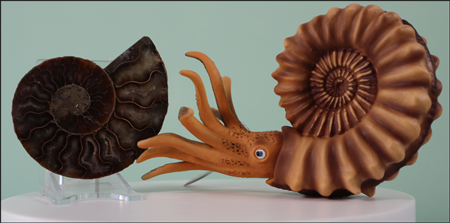Prehistoric Animal Fossil Replica Set
When members of the Everything Dinosaur team visit schools we get bombarded with questions from students and teachers about dinosaurs and we recommend our prehistoric animal fossil replica set to them. These animals are certainly the super stars of palaeontology. However, when we are carrying out experiments or teaching exercises with school children we like to introduce other prehistoric animals and their fossils to help pupils gain a more rounded picture regarding the evolution of life on Earth.
Not all fossils are dinosaur fossils for example, quite a difficult concept to get over to a dinosaur mad five-year old. Some of the most important types of fossil are not huge when compared to the immense fossilised bones of a Tyrannosaurus rex, but they can be very important to scientists. Certain types of fossil such as ammonites and trilobites are extremely important as they help scientists date the ages of strata relative to one another.
The use of fossils to help date the relative ages of different rock formations is called biostratigraphy. It was the English engineer William Smith, known as the “Father of Geology” who along with the French scientists Georges Cuvier and Alexandre Brongniart observed that successive layers of sediment contained fossils that were characteristic of certain periods of ancient history. The discovery of the relationship between fossils and certain geological periods opened up the prospect of using fossils to establish a relative sequence of rock deposition through time.
The types of fossil used to help date rocks in this way are called “zone fossils”. Despite all the attention dinosaur fossils receive and the vast amount of museum gallery space allocated to them, dinosaur fossils along with most other types of vertebrate fossils are very poor zonal fossils. Ideally, for a family or genus of animals to become useful zone fossils they should be rapidly evolving, be distinctive in appearance, wide ranging and abundant in the ecosystem. If you live in a shallow sea, and have a hard exoskeleton or shell then this is even better as there is a greater chance of some members of your species being preserved as fossils buried in marine sediments.
Dinosaur fossils in contrast, are rare, often found as incomplete remains and not from marine environments (only in very unusual cases – Scelidosaurus springs to mind). They are unsuitable as zone fossils. Not so the ammonite and trilobite which make ideal zone fossils and have helped to date rock strata in relation to other rock formations all over the world.
The importance of fossils of animals such as belemnites, ammonites and trilobites cannot be underestimated. What is more, most young palaeontologists start their fossil collection with the find of a fossil of an invertebrate, a brachiopod for instance, or perhaps their very own ammonite.
In recognition of the importance of invertebrates in the fossil record, Everything Dinosaur has introduced a set of replica models to illustrate these animals.
Everything Dinosaur Replica Fossil Set

Picture credit: Everything Dinosaur
The set consists of two different types of ammonite, a belemnite (close relative of ammonites) a typical trilobite and a model of a Medusa jellyfish as a representative of soft-bodied animals in prehistory.
Model of an Ammonite

The Bullyland ammonite model is often used in museum displays to depict the living animal next to fossil material. Picture credit: Everything Dinosaur.
Picture credit: Everything Dinosaur
Each model comes with a fact sheet written by Everything Dinosaur team members, these robust and sturdy models with their detailed hand-painted designs represent other animals from the past.
To view dinosaur toys, dinosaur models and other fossil replicas: Replica Fossils and Dinosaur Models.
Whether it is for a school project, home study or just to add to a model collection, these accurate prehistoric animal models certainly hit the mark and can provide a stimulus for further study.






Leave A Comment